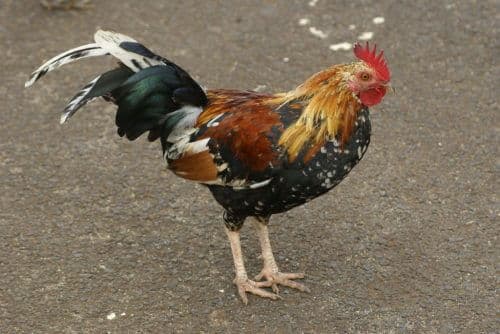What happens to domesticated animals that become wild animals? The results of a new study reveal that some of the features they adapted to themselves are also preserved in nature and help them survive in it
Dr. Daniel Mader - Angle - Science and Environment News Agency

The island of Kauai in Hawaii is full of wild chickens. They are everywhere - on the beaches, in the streets and in nature. Locals claim that the wild chickens were once domesticated, and they spread across the island after strong hurricanes hit it, and many chickens were damaged. Even some of the chickens that did remain in the human environment did not receive adequate care because they were busy rebuilding their lives, therefore they had to manage on their own.
The domesticated chickens met in the forests a breed of Polynesian chicken that came to Hawaii together with Polynesian settlers hundreds of years ago. This species was also domesticated in the past and became a wild species. A new study published in the journal Nature presents DNA analysis showing that the current chicken invasion on Kauai is the offspring of modern domesticated chickens mating with the same ancient Polynesian breed.
Even though it's only been a few decades since the chickens went free, we can already talk about the evolution they've gone through since for them tens of generations have passed. The new wild variety combines features from both sources - it is large, similar to the domesticated variety, but probably lays eggs once or twice a year, and not all year round as domesticated varieties do. The researchers who looked into the matter saw that the domestic chickens had patches of white feathers similar to those found in domesticated chickens of modern breeds, in addition to the black feathers common to wild breeds. The yellow legs and distinctive croak also came from the civilized gardens, as the wild chickens have gray legs and a completely different croak.
The chickens of the current wild breed are slightly afraid of humans and do not approach them, but they roam freely in an urban environment at a distance of a few meters from people - similar to domesticated chickens, and in complete contrast to the Polynesian breed. This behavior protects them from random harm by humans, but allows them to reach elite food sources in the human environment such as manure and food for domesticated animals.
The hens and roosters that survived and produced more offspring are the ones that incorporated traits better suited to their new reality. It seems that some of the traits that the domesticated animals acquired while living alongside man (and it would be more correct to say that man created many individuals that he preferred) actually benefit them when they become wild again, especially if their new life is in an environment close to people. Perhaps this is a successful way for wild species to survive in a human-dominated world with very few truly wild corners.
Kauai's chickens are not the only ones that have gone through a process of feralization and there are quite a few domesticated animals that have become wild animals - horses in North America, stray cats and stray dogs all over the world and in Israel, pigs in Sardinia and the USA and sheep in Scotland.
The new research sheds light on the processes of feralization of domesticated animals, helps to understand how their transition from areas inhabited by humans to the wild affects wild animal populations (and especially wild populations that are close to the feralizing animal, or even the ancestor of the feralizing animal such as dogs and wolves), And how it will be possible to control these transitions to reduce damage to the environment.
